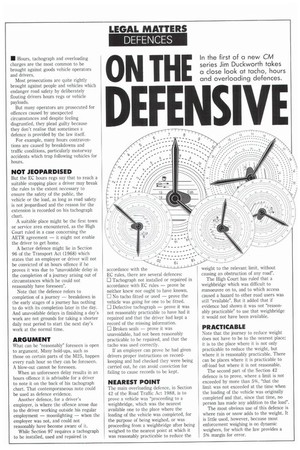ON THE
Page 46

If you've noticed an error in this article please click here to report it so we can fix it.
EFENSIVE
• Hours, tachograph and overloading charges are the most common to be brought against goods vehicle operators and drivers.
Most prosecutions are quite rightly brought against people and vehicles which endanger road safety by deliberately flouting drivers hours regs or vehicle payloads.
But many operators are prosecuted for offences caused by unexpected circumstances and despite feeling disgruntled, they plead guilty because they don't realise that sometimes a defence is provided by the law itself.
For example, many hours contraventions are caused by breakdowns and traffic conditions, particularly motorway accidents which trap following vehicles for hours.
NOT JEOPARDISED
But the EC hours regs say that to reach a suitable stopping place a driver may break the rules to the extent necessary to ensure the safety of the public, the vehicle or the load, as long as road safety is not jeopardised and the reason for the extension is recorded on his tachograph chart.
A suitable place might be the first town or service area encountered, as the High Court ruled in a case concerning the AETR agreement — it might not enable the driver to get home.
A better defence might lie in Section 96 of the Transport Act (1968) which states that an employer or driver will not be convicted of an hours offence if he proves it was due to "unavoidable delay in the completion of a journey arising out of circumstances which he could not reasonably have foreseen".
Note that the defence refers to completion of a journey — breakdown in the early stages of a journey has nothing to do with its completion later in the day. And unavoidable delays in finishing a day's work are not grounds for taking a shorter daily rest period to start the next day's work at the normal time.
ARGUMENT
What can be "reasonably" foreseen is open to argument. Many hold-ups, such as those on certain parts of the M25, happen every rush hour so they can be foreseen. A blow-out cannot be foreseen.
When an unforeseen delay results in an hours offence it is advisable for a driver to note it on the back of his tachograph chart. That contemporaneous note could be used as defence evidence.
Another defence, for a driver's employer, is where the offence arose due to the driver working outside his regular employment — moonlighting — when the employer was not, and could not reasonably have become aware of it.
While Section 97 requires a tachograph to be installed, used and repaired in accordance h the EC rules, there are several defences: Tachograph not installed or repaired in accordance with EC rules — prove he neither knew nor ought to have known. LI No tacho fitted or used — prove the vehicle was going for one to be fitted. 0 Defective tachograph — prove it was not reasonably practicable to have had it repaired and that the driver had kept a record of the missing information. 0 Broken seals — prove it was unavoidable, had not been reasonably practicable to be repaired, and that the tacho was used correctly.
If an employer can prove he had given drivers proper instructions on recordkeeping and had checked they were being carried out, he can avoid conviction for failing to cause records to be kept.
NEAREST POINT
The main overloading defence, in Section 42 of the Road Traffic Act 1988, is to prove a vehicle was "proceeding to a weighbridge, which was the nearest available one to the place where the loading of the vehicle was completed, for the purpose of being weighed, or was proceeding from a weighbridge after being weighed to the nearest point at which it was reasonably practicable to reduce the
weight to the relevant limit, without causing an obstruction of any road".
The High Court has ruled that a weighbridge which was difficult to manoeuvre on to, and to which access caused a hazard to other road users was still "available". But it added that if evidence had shown it was not "reasonably practicable" to use that weighbridge it would not have been available.
PRACTICABLE
Note that the journey to reduce weight does not have to be to the nearest place; it is to the place where it is not only practicable to reduce the weight, but where it is reasonably practicable. There can be places where it is practicable to off-load but where it is not reasonable.
The second part of the Section 42 defence is to prove, where a limit is not exceeded by more than 5%, "that the limit was not exceeded at the time when the loading of the vehicle was originally completed' and that, since that time, no person has made any addition to the load".
The most obvious use of this defence is where rain or snow adds to the weight. It is little used, however, because most enforcement weighing is on dynamic weighers, for which the law provides a 5% margin for error.




















































































